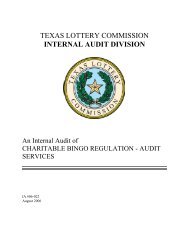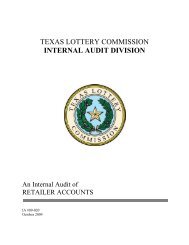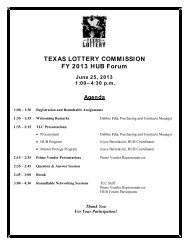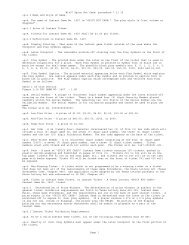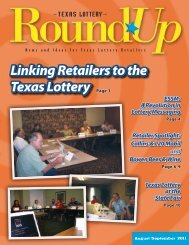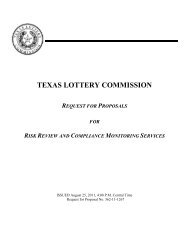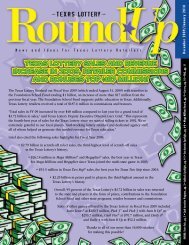Charitable Bingo Operations Business Plan - Texas Lottery
Charitable Bingo Operations Business Plan - Texas Lottery
Charitable Bingo Operations Business Plan - Texas Lottery
You also want an ePaper? Increase the reach of your titles
YUMPU automatically turns print PDFs into web optimized ePapers that Google loves.
Challenges and Opportunities<br />
One of the most significant differences between the instant and on-line game playing experience is the time<br />
that elapses between buying the ticket and the player finding out if the ticket is a winner. For example, a<br />
player who purchases a ticket for the Lotto <strong>Texas</strong> on-line game on a Sunday morning must wait until the Lotto<br />
<strong>Texas</strong> drawing occurs on Wednesday night to determine if a prize has been won. In contrast, as soon as an<br />
instant ticket is scratched, the player immediately knows if the ticket is a winner. Most prizes can be paid<br />
immediately at a retail location, creating an opportunity for a subsequent ticket purchase.<br />
On-line games, industry wide, have relied primarily on jackpot levels to drive sales and revenue generation.<br />
Lotteries nationwide are attempting to increase on-line game sales by exploring the introduction of higher price<br />
points. However, lotteries have struggled in these efforts, as players have become accustomed to playing for<br />
multi-million dollar jackpots for a $1 wager. This has limited the industry’s ability to create the value<br />
proposition differential between price points that has been so successful with the instant ticket product category.<br />
As noted above, lotteries nationally have recently collaborated to expand the offering of multi-jurisdictional<br />
jackpot games (Mega Millions and Powerball) across significantly larger population bases. This expansion of<br />
the on-line jackpot game offerings in <strong>Texas</strong> requires the continued monitoring of jackpot and daily (nonjackpot)<br />
game performance for possible modifications and adjustments to the overall on-line game portfolio.<br />
Multi-state games like Mega Millions and Powerball are capable of generating jackpots upwards of $300<br />
million, creating excitement for players and retailers alike, and also driving sales. While the agency enjoys<br />
the benefits of these large jackpots and the strong sales associated with them, they can create a phenomenon<br />
known in the lottery industry as “jackpot fatigue.” This phenomenon causes players to become desensitized<br />
to smaller jackpot amounts, and ever-larger jackpots are required to garner the attention and excitement of<br />
players. The lottery industry, including <strong>Texas</strong>, has relied on the jackpot-style games to reach large jackpot<br />
amounts in an effort to increase sales. However, due to jackpot fatigue, sales and revenue for this type of online<br />
game have generally decreased over time.<br />
New on-line games and/or game changes require execution of the agency’s formal administrative<br />
rulemaking process and extensive system software development before introduction. Additionally, on-line<br />
games typically require costly advertising expenditures to communicate to the public about the new product<br />
or changes to an existing product. These games differ from instant tickets, as the instant game serves as its<br />
own communication vehicle due to its visible placement at retail. These on-line product requirements serve<br />
to limit the agency’s ability to conduct frequent introductions of new on-line games or make rapid changes<br />
to existing games.<br />
- 20 -




